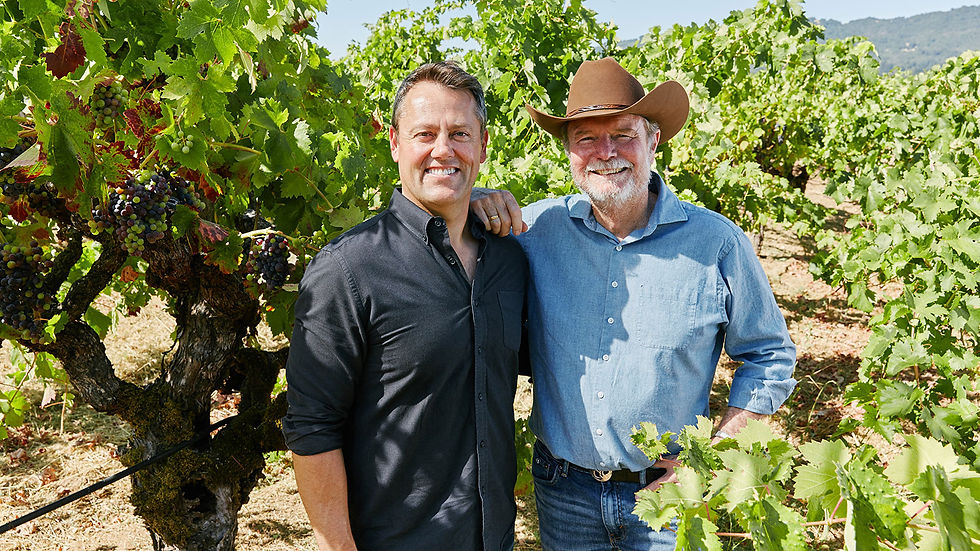Zinfandel Emerging Into Fuller Bodied Wine
- by The Wine Guys, Tom Marquardt and Patrick Darr
- Jun 27, 2017
- 4 min read

Zinfandel has taken a strange and often twisted course in its evolution. Even more so than pinot noir, zinfandel's route has enough ups and downs to make a sober person tipsy. Once the pride of Italian immigrants who found California's hot regions had ideal growing conditions, zinfandel struggled to gain footing in a market that idolized noble French varieties like cabernet sauvignon and pinot noir.
It's struggle has been worsened internationally by its near exclusivity to U.S. soil. With a few exceptions, zinfandel is not planted anywhere else, although it is thought to be a relative of Italy's primitivo grape and has its origins in Croatia. It's certainly not the only grape variety confined to one growing region, but outside of the United States zinfandel just isn't in the game.
Gaining recognition has been hobbled by episodic diversions, too, most notably the white zinfandel craze that associated the variety with sweet, cheap plonk. Although white zinfandel sales are quickly declining, it nearly doubles red zinfandel in sales.
But there was once a zenith when zinfandel was a cult wine made by dedicated craftsmen in appellations such as Dry Creek Valley. We fondly remember the days when small producers like Rafanelli, Grgich Hills, Edmeades, Ridge, Hendry, and others were competing for attention. In the right hands and in the right regions, zinfandel can earn special recognition.

Gary Sitton, left, is taking over winemaking for Ravenswood founder, Joel Peterson.
We were musing zinfandel's odyssey the other day while talking to Gary Sitton, director of winemaking for Ravenswood. Sitton knows the grape's track record all too well. He is slowly transitioning into the pilot seat as Ravenswood's founder, Joel Peterson, moves into semi-retirement. Peterson is known as the "godfather of wine" for elevating the brand to iconic status decades ago. At one time, Sitton said Ravenswood accounted for one out of every four bottles of zinfandel sold.
Peterson sold the facility to Constellation Brands in 2001 and, like all conglomerates, Constellation sought to increase profits by exploiting its most popular wine. Ravenswood's iconic Vintner's Blend became a supermarket staple and annual production was increased to 500,000 cases. It's a deal at about $10 a bottle, but it's a shadow of Peterson's original version.
However, Ravenswood's chances of putting the genie back in the bottle rests in its single-vineyard zinfandels. We've been tasting these wines for more than a decade and they remain impressive – still the handcrafted wines we remember.
"We are at the crossroads as Ravenswood started out as a high-end, cult status brand," Sitton said. "We've grown the appellation tier of our zinfandel and out of necessity we started growing the Vintner's Blend. When you start that, you are wildly successful. But at the same time you try to remain relevant."
He said there has been some erosion of the brand's presence in restaurants because owners just won't put a brand on the wine list that can be found in supermarkets. Instead, he said the tasting room and club sales have picked up some of the slack. Ravenswood's appellation series and single-vineyard series are seeing growth.
Another interesting twist in zinfandel's lifespan has been its increased presence in California blends, an emerging market for consumers. A prolific, high-yielding grape variety that can be planted in places like Lodi where land is relatively cheap, zinfandel is an inexpensive foundation grape for a lot of upstart brands. Sitton doesn't see this as a threat, though.
"I don't fear zinfandel becoming a generic blending grape," he said. "It's a beverage wine like white zinfandel and Yellowtail. Yes, you do have a lower price point but this is a positive emergence into a fuller bodied wine....it's an opportunistic category."
Sitton feels that the best zinfandel is not over-extracted but full bodied and balance, not overripe or over-oaked. He said the single-vineyard zins – just a few in a portfolio of 30 wines of many grape varieties – showcase the stellar vineyards that has been in the Ravenswood family for years.
These single-vineyard zins have the best chance to buff the patina from this storied brand:
Ravenswood Teldeschi Zinfandel 2013 ($39). Wow, what a mouthful of Dry Creek Valley bliss. Full bodied, dense, tannic and loaded with blueberry and blackberry flavors with healthy doses of licorice and chocolate. Petite sirah accounts for 19 percent of the wine and its color. This is a wine to serve with serious barbecue.
Ravenswood Old Hill Zinfandel 2014 ($39). We like the floral and anise aromas in this smooth but deceiving single-vineyard wine. It has the classic varietal flavors of blackberries with a dash of pepper.
CHARDONNAY PICKS
Sonoma-Loeb Envoy Chardonnay 2015 ($38). Chappellet acquired this property in 2011 and has been applying its magic to some pretty good grape sources. We're betting good things will come to this chardonnay and pinot noir house. The Envoy, made in small quantities, hits all the right notes for those who like their chardonnay rich and lush: tropical fruit flavors with lemon and peach notes and a healthly dose of vanillin oak.
Stonestreet Estate Chardonnay 2015 ($40). Rich texture with noticeable oak and ample peach/lemon curd flavors. Vanillin oak with some citrus notes.
La Crema Sonoma Coast Chardonnay 2015 ($23). A good value, this chardonnay is round and medium-bodied with lemon aromas and melon, peach flavors. Soft on the palate with a hint of spice and lemon.
Miner Family Winery Wild Yeast Chardonnay 2012 ($50). This heady and rich, full-bodied chardonnay has the guts to stand up to the most complicated seafood dishes yet is delicious to enjoy by itself. Luxurious in texture, it has ripe pear and melon notes with a dominant dose of butterscotch.

